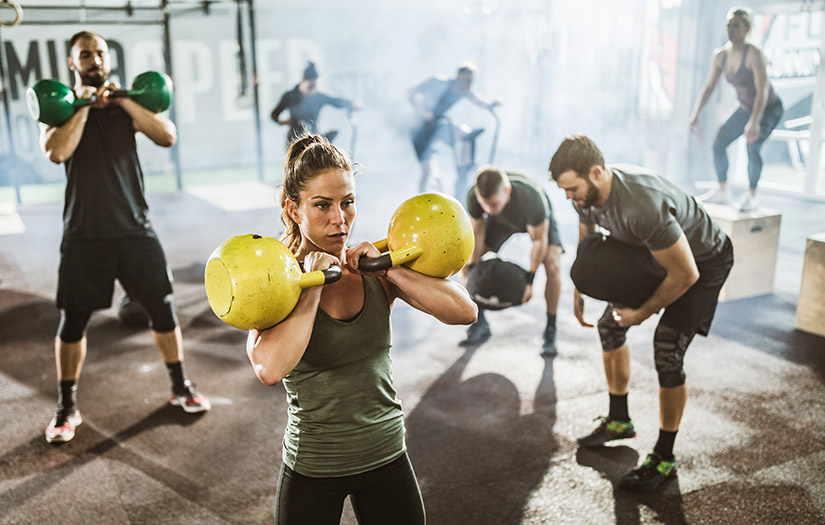By KINSEY MAHAFFEY
The term “circuit training” is widely used by fitness professionals, magazines, gyms, and fitness classes. If you did a google search to find circuit training classes in your area, no two classes would likely look precisely the same.
One class might use a variety of equipment, while another might use no equipment at all. One circuit training class might look intense, while another advertises itself as low-impact and suitable for beginners.
With such a seemingly broad range of classes all marketing themselves as “circuit training,” it might leave you wondering what circuit training is and whether or not it’s right for you – especially if you are wanting to become a personal trainer and eventually design circuit training programs for clients.
WHAT IS CIRCUIT TRAINING?
Each exercise is performed in a circuit training workout one after another with little to no rest in between exercises. Usually, there will be 8-10 exercises in a circuit, although this number can vary depending on how much time you have.
You can perform a certain number of reps for each exercise (8-20 reps), or you can time each exercise (30-60 seconds per exercise). Once you go through each exercise in the circuit, you can take a slightly longer rest (about 1 minute) to recover before beginning the circuit again. Repeat the circuit 1-3 times or for the duration of your allotted workout time.
WHAT ARE SOME EXAMPLES OF CIRCUIT TRAINING?
To get the most bang for your buck in circuit training, it’s best to perform a full-body workout. Here’s an example of an intermediate full-body strength circuit training program:
| Exercise | Reps | Sets | Rest |
| Push-ups | 12-15 | 1-2 | 0-15 seconds |
| Dumbell squat | 12-15 | 1-2 | 0-15 seconds |
| Bent over dumbbell row | 12-15 | 1-2 | 0-15 seconds |
| Alternating lateral lunges | 12-15 | 1-2 | 0-15 seconds |
| Biceps curl to overhead press | 12-15 | 1-2 | 0-15 seconds |
| Romanian Deadlift | 12-15 | 1-2 | 0-15 seconds |
| Ball crunch | 12-15 | 1-2 | 0-15 seconds |
| Ball back extension | 12-15 | 1-2 | 60 seconds |
Training circuit-style is bound to keep the heart pumping, but if you like to incorporate some cardio exercises into your routine, here’s an example of what that might look like:
| Exercise | Reps | Sets | Rest |
| Chest Press | 12-15 | 1-2 | 0-15 seconds |
| Dumbbell squat | 12-15 | 1-2 | 0-15 seconds |
| Jump Squats | 8-10 | 1-2 | 0-15 seconds |
| Standing cable rows | 12-15 | 1-2 | 0-15 seconds |
| Step up with biceps curl | 12-15 | 1-2 | 0-15 seconds |
| Mountain climber (hands-on step) | 20-30 seconds | 1-2 | 0-15 seconds |
| Ball crunch | 12-15 | 1-2 | 0-15 seconds |
| Ball back extension | 12-15 | 1-2 | 60 seconds |
These circuit examples are a great starting place, and you can adapt the exercises to suit your personal preferences and/or the equipment that you have available.
If you’ll be performing your circuit in a busy gym environment, it’s important to plan for limited access to space and equipment. Proper gym etiquette encourages that you use the minimum amount of space and equipment that’s needed so that others can also work out without having to wait for a machine that you’re only using for part of your circuit.
For example, instead of writing a workout that requires three different sets of dumbbells, a bench, and a cable machine, I may plan to use just one or two sets of dumbbells and a ball for an entire circuit. That way, I don’t have to worry about people giving me the side-eye as I do my workout.
IS CIRCUIT TRAINING SAME AS HIIT?
HIIT training is another popular style of training that can often get confused with circuit training. Some will use the terms HIIT and circuit training interchangeably, but they really are quite different when performed as intended. The main differences between HIIT and circuit training are the intensity of the work periods, the length of rest between bouts of work, and the total amount of workout time.
HIIT stands for High-Intensity Interval Training. In a HIIT workout, you will perform an exercise (typically a cardio exercise) at 95-100% maximum effort for a short period of time, usually, 30 seconds or less, followed by as much rest as is needed to recover. Your rest can be active, such as walking until the heart rate lowers. A simple example would be a 100-meter sprint followed by a walk around the track to get back to the starting point to recover before doing another sprint.
A true HIIT workout is performed at maximum efforts during the work periods, includes sufficient rest between bouts of work, and will only last 15-25 minutes total. A circuit training workout is performed at a medium intensity during the work periods, includes little to no rest between bouts of work, and can last 30-60 minutes. Even if a circuit training workout consists of only cardio exercises, there often isn’t enough recovery time between exercises to allow for true maximum effort in each exercise.
As a general rule, the higher the intensity of a workout, the shorter the workout will be and the longer the recovery will be between bouts of movement.
WHAT IS THE PURPOSE OF CIRCUIT TRAINING?
The purpose of this style of training is to get the most bang for your buck. Circuit training is popular because it is the most time-efficient way to perform a full workout.
Because circuit training uses little to no rest, you’re able to complete the workout in a shorter amount of time than you would perform each exercise one at a time with rest in-between sets.
WHAT ARE THE BENEFITS OF CIRCUIT TRAINING?
There are many benefits to choosing circuit training. My clients love doing circuits because they say it makes the workout feel like it flies by (seriously!). Even better, when we time the circuits, no one has to count! Here are just a few of the other benefits of circuit training:
BUILT-IN REST PERIODS
Even though there’s little to no rest between exercises, circuits allow you to train each muscle group of the body without overdoing it.
You might start with an exercise using the chest and triceps, but then you’ll have seven other exercises using different muscle groups to let your chest and triceps rest before you return for a second (or third) set.
PERFECT FOR ALL LEVELS
Circuits are easy to make more challenging or less challenging simply by manipulating the order of exercises and/or the rest time between exercises. Beginners can start by alternating upper body and lower body exercises in the circuit, and they might even choose to include 15-30 seconds of rest between exercises.
Intermediate exercisers can eliminate the rest for an increased challenge. Intermediate-advanced exercisers can up the ante by doing several upper body exercises in a row followed by several lower body exercises in a row to increase the challenge. There are many ways to get creative with a circuit. Just remember to start with small changes over time to let your body adapt and prepare for the next challenge!
HIGHER CALORIE BURN, LESS TIME
If you’re used to going through your workout one exercise at a time, transitioning to circuit training will shorten your workout and allow you to burn more calories in that period of time than you did previously.
Due to the shorter rest periods, circuits keep the heart rate up, which increases the calorie burn. Plus, the efficiency of this workout makes it perfect for anyone who has a busy schedule or doesn’t want to spend more than 30-60 minutes in the gym.
HOW MANY TIMES A WEEK SHOULD YOU DO CIRCUIT TRAINING?
If you’re performing full-body resistance circuits (similar to our examples above), you’ll want one or two days of rest between circuits. This means you can do circuit training 2-3 times per week to allow for sufficient recovery.
IS CIRCUIT TRAINING GOOD FOR WEIGHT LOSS?
Whether you’re looking to lose weight, train clients to lose weight, increase your fitness, or improve your muscle tone, circuit training is a great option for you. This training style keeps you moving the entire workout session, which increases the heart rate and, therefore, the overall caloric burn during the session to aid in weight loss. Additionally, this style of training can be performed by gym-goers at all levels!
If you’re looking for ways to make your workouts more time- and calorie-efficient, more interesting, or you’re looking for a new workout style to try, circuit training may be a great option for you.
THE AUTHOR

KINSEY MAHAFFEY
Kinsey Mahaffey, MPH, is a Houston-based fitness educator, personal trainer and health coach who developed her commitment to lifelong fitness while playing Division I volleyball. She’s passionate about helping others cultivate a healthy lifestyle and enjoys educating other fitness professionals who share this vision. She’s a Master Instructor and Master Trainer for NASM.

